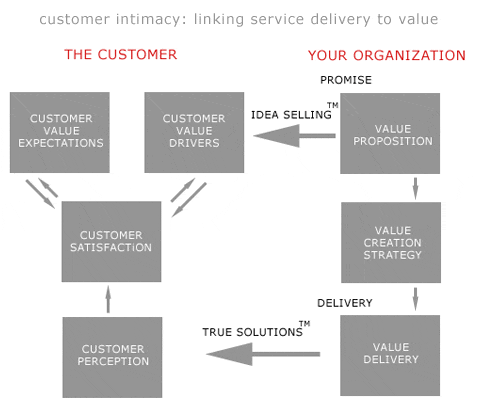Eighty-eight percent of all CEOs say getting closer to the customer is the most important dimension to realize their strategy in the next five years. According to an IBM study, “The most successful organizations co-create products and services with customers, and integrate customers into core processes. They are adopting new channels to engage and stay in tune with customers. By drawing more insight from the available data, successful CEOs make customer intimacy their number-one priority.”
This is not news for anyone who views Customer Intimacy as a business model and not just a sales technique. One of the key tenets of a superior customer intimacy practice is to constantly maintain a tight linkage between service delivery and value creation. In fact, by definition, you can’t have real customer intimacy if you’re not solving your customer’s most strategic issues.

The diagram above makes the following point: there must exist an optimal balance between your promise and your delivery, i.e., you gotta walk the talk. Further, the value proposition you bring to your client must impact your customer’s value drivers in a perceptible way. Once you have convinced the customer that your idea will in fact deliver value (Idea Selling), then you must in fact deliver what you promised. In our case, we say that you must offer True Solutions and be an intimate partner in solving problems and bringing new ideas to your clients. Of course, you also have to keep in mind that your ideas or propositions must be screened to ensure they meet your criteria for fostering Customer Intimacy.
If your solutions don’t deliver on your value proposition, you’re guilty of marketing hype. This can be a fatal mistake. Far too many companies believe their own marketing propaganda, and don’t know how to deliver on their marketing promises. 90% of the time, this is why Customer Intimacy gets a bad rap.
Now, a few words about customer value drivers. We’re all indebted to the academician Jag Sheth‘s theoretical model that explains the five values that drive customer choice:
- Functional value: the perceived utility that derives from a product’s physical, utilitarian, or functional attributes.
- Social value: derived from an alternatives association with an identified demographic, socioeconomic, cultural, or ethnic group.
- Emotional value: derived from the ability of an alternative to arouse an emotional or affective state.
- Epistemic value: acquired by an alternative as the result of its ability to arouse curiosity, provide novelty, and/or satisfy a desire for knowledge.
- Conditional value: derived from the specific situation or context of the purchase decision.
At McMann & Ransford, we help our clients build True Solutions that meet all five customer values. Unfortunately, far too many companies are focused on functional value alone, a classic symptom of the product-driven company.
